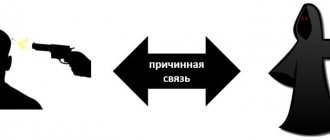Criminal law is the most significant legal area of great social importance.
In close conjunction with other branches of law, such as criminal procedure, correctional labor, and criminal law, it performs a significant function that allows one to classify acts as crimes and determine the procedure for applying responsibility for committing criminal acts. The essence of the criminal law reflects the object of the crime, which is an element of any illegal act. Multi-channel free hotline Legal advice on criminal law. Every day from 9.00 to 21.00
Moscow and region: +7 (495) 662-44-36
St. Petersburg: +7 (812) 449-43-40
The concept of the object of a crime
The socio-legal science of criminology deals with the study of the conditions and motives of crime, the description of the criminal as an individual, and the determination of methods and methods of prevention and prevention of lawless actions. The subject of this science is relations related to crime and criminal acts. A crime is a socially threatening action, with punishment for guilty involvement in it. It is possible to bring the guilty person to justice only in cases where these acts contain a criminal element specified in the Criminal Code of the Russian Federation.
The crime is divided into four components:
- The object is what is being violated: life values, other benefits that are or may be damaged by a criminal act.
- The subject is a person capable of delict (a person who understands all the consequences of his actions and can be legally held accountable for them).
- The objective side is a component of a criminal act, externally reflecting the act itself, dangerous for society, causing harm to the victim.
- The subjective side is a component of a criminal action of an internal nature, reflecting how the subject of a specific crime in criminal law is connected with the crime he committed and its consequences.
The subjective side also includes the mental state of the criminal.
Using the example of lawlessness, which manifests itself in the violation of the equality of rights of a citizen, it is clear that the object is the constitutional principle of equality.
The subject of criminal law here is a person using his official position. The objective side in the above example is discriminatory actions, which depend on the following factors:
- gender, race, language variety;
- position, ownership of property;
- religious beliefs;
- participation in public associations or belonging to certain social groups.
An example would be a refusal to register a citizen based on his ethnicity at his place of residence, or a refusal for political reasons to an applicant for a job vacancy.
From the subjective side, this criminal act, like a more serious one, for example, murder, is characterized only by direct intent.
The object of the crime is a scientific category. Since the times of Roman law and legal codes of monarchical Russia, its establishment and study has become a central link in the practice and theory of criminal legislation.
In the science of criminal law, there are different views and opinions on this matter; a large number of scientific works, monographs, lectures, and books on jurisprudence have been written. However, the main doctrine briefly defines a criminal object as a social relationship that is subject to encroachment through the commission of criminal acts, or this encroachment creates a danger of causing damage or other harm.
This formulation explains the need to create criminal legislation, the areas of its application, and the relationships that it protects.
These protected relationships are located in a certain hierarchy:
- Personality.
- Economy.
- The power of the state.
- Security and so on.
The idea of the object of a crime closely borders on the concept of social danger, which is a characteristic property of a criminal act.
The concept of the object of a crime in criminal law is closely related to a significant feature of the objective side of a lawless act - a socially dangerous outcome. This property serves as an indicator of the specific focus of a particular type of attack.
For example, the objective side of a criminal act under Art. 228 of the Criminal Code of the Russian Federation, the following actions are acceptable:
- illegal acquisition of drugs, neurotropic drugs and their analogues;
- production, drugs and their transportation;
- processing of narcotic raw materials without the purpose of sale.
The object of the crime under this article is relationships related to human health.
In the classification of the object of a crime, two separate subelements are distinguished.
Subject of the crime
The objects of criminal actions include real property or other material objects, spiritual values that are being violated. At its core, the subject is a reflection of what social relationships look like in reality.
For example, when talking about illegal acts against property, it is clear that they cannot be directed towards something non-specific, intangible. Thus, the subject of the crime of “theft” is always aimed at specific property, money, and other material objects that are subject to the circumstances of the case. By influencing, conditionally, the money in the victim’s wallet, the perpetrator thus influences the object of the crime in criminal law - the victim’s property rights, social relations, and thereby commits a criminal act.
In cases of theft, a distinction is made based on the subject of the criminal act. If this is ordinary theft, for example, of the same funds, then it is qualified under Article 158 “Theft”. If this is theft, for example, of explosive or nuclear substances, then this is a separate article. There are separate articles on the theft of weapons, ammunition, stamps, seals, excise stamps, and so on.
The subject of the crime expresses the essence of the object, and in individual cases it will be different.
So, in the example of the theft of weapons, the object will be security, although there is also a right of ownership to the weapon, and the owner is harmed. Therefore, for qualification this is of fundamental importance, since a mistake can cost re-qualification and the return of the case by the court. A court decision that has already been made is subject to an appeal and reversal of the decision.
Victim of a crime
The victim of criminal acts, like the object, is not included in all compositions. The identification of this sub-element in criminal law is necessary, since the victim is not only a specific individual suffering from harm caused (moral, personal, property), but also a legal entity that can also be harmed by committing theft, fraud, or causing harm to a business. reputation and so on.
The victim is an interested person, a procedural participant, in most cases the subject who files a statement about a criminal attack on him, which is the basis for initiating a case.
The victim may have certain characteristics that will affect qualifications. For example, committing criminal acts against a minor is classified more seriously. For some crimes, harm can only be caused to minors, for example, involvement in criminal or antisocial activities (begging, alcoholism).
A serious crime committed against a woman who is pregnant also entails a more severe classification, a more severe punishment for the person who committed this malicious act.
The status of a victim is assigned during the conduct of a criminal case or pre-investigation check. The victim has the right to protect his interests, since he is also a full participant in the process.
Offenses are not recognized as the object of a crime. Rules of law are not the object of encroachment, since sometimes a criminal act encroaches on relationships that are not regulated by law. Criminal legal relations do not exist until the moment of committing a crime, just as the subject of this legal relationship does not exist. Also, the subjects of criminal law differ from the subjects of offenses.
The meaning of the object of the crime
Having recognized social relations as the object of a crime, it is permissible to give an explanation of the social danger of the act, to provide an answer to the questions of why it has a socially dangerous significance, what this significance consists of, and when the legal necessity of punishment occurs.
The main and fundamental significance of the object of the crime is the codification of legislative criminal law, which allows:
- Determine the correct qualification of a criminal act.
- Divide related elements by establishing which object of the crime in criminal law is being encroached upon.
A reliable determination of the object of the attack makes it possible to establish the boundary between a criminal act and other offenses that go beyond the law.
Unmistakably identifying the object of a crime allows you to:
- identify the nature and level of social threat from encroachment;
- establish what protected good the crime is aimed at;
- determine the material essence of the crime.
Qualifying the object of a crime as a social relationship makes it possible to explain the seriousness of a criminal act for society.
Criminal law as an academic discipline
Criminal law as an academic discipline is a system of knowledge taught according to a specific program in legal educational institutions, arranged in a formally logical and legally sound sequence in the form of relatively independent topics and questions, covering:
- theoretical, conceptual and normative content of the criminal law industry;
- goals, grounds and conditions for the application of criminal law;
- the existing practice of application of criminal law by state law enforcement agencies.
0
5
Types and examples of crime objects
The scheme of objects of crime in the science of criminal law is divided both vertically and horizontally. The vertical hierarchy is represented by four types of objects.
General
The general object is a purely scientific concept that does not have direct significance for practice, but gives a general understanding, for example, what is the difference between an offense and a criminal violation, when an offense is considered an administrative violation, and in what cases - judicially punishable.
Generic
The general object is divided into types.
A special part of the Criminal Code is built on the principle of dividing all offenses into sections and chapters. The section corresponds to the generic type of the crime object. It contains a group of similar relationships protected by one section. These may include:
- Personality.
- Own.
- Moral.
- Human security, peace.
So, according to Art. 292 of the Criminal Code of the Russian Federation “Forgery of Officials”, the object of a criminal act is the ordinary activities of government agencies, and the generic object is the interests of this public service.
Species
The generic section marks a narrower circle or group of social connections protected by law—species objects.
Thus, within one section concerning the economic sphere, there are 3 chapters relating to the following types of illegal actions directed against the following interests:
- property;
- interests of the economy;
- interests of commercial organizations.
Species objects have differences from each other, that is, different relationships protect the needs of different circles of people. This approach is necessary to qualify a criminal act.
Direct
The direct object is certain relationships that are targeted by malicious acts, which are noted in a separate crime when it is classified.
Using the example of commercial bribery, we can trace the composition of this object:
- General - relations in economics.
- Generic - economic sphere.
- Species - official interests of the organization.
- Direct - interests in the formation of relationships in the legitimate activities of organizations.
In this regard, there is a need to separate the immediate object horizontally.
The following direct objects are distinguished:
- Basic. The main object includes relations protected by the rule of law adopted to protect them. Rarely, but there are circumstances when one element of a criminal act relates to two objects of encroachment at once. A classic, two-object example is robbery, where in addition to property there is a person. Robbery is placed in the chapter devoted to criminal actions directed against property, that is, this recognizes that property is the main object, and the person is an additional one.
- Additional. An additional object always suffers in one form or another. According to this legislation, it was important to determine which object it would be preferable to direct a crime in the main status to protect. The additional object must be indicated in the article, that is, in the specific corpus delicti.
- Optional. The optional object is not directly named in the article. It is needed to describe how dangerous the act is to society, how many people it causes harm, except for the victims. This type is important for qualification.








